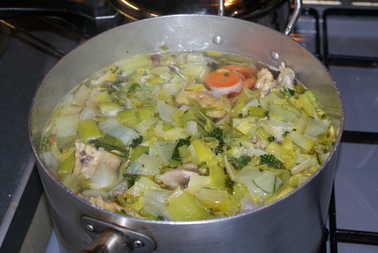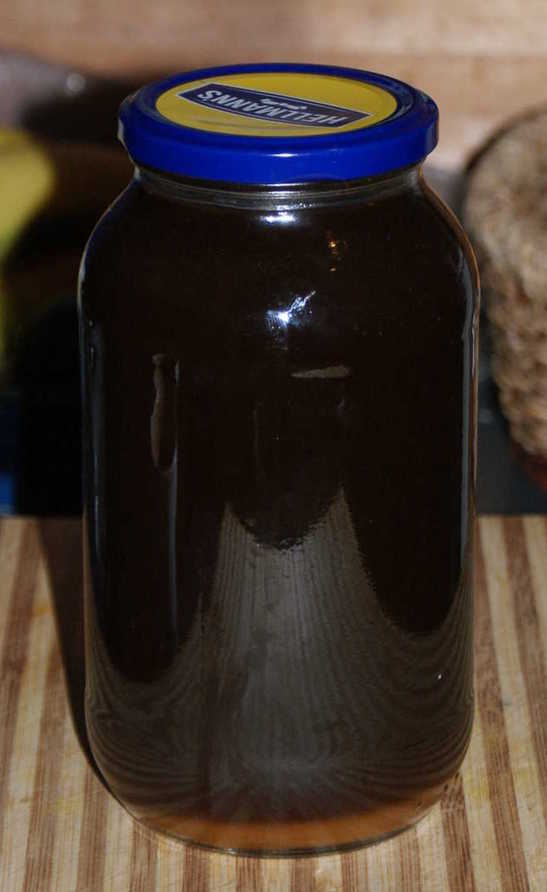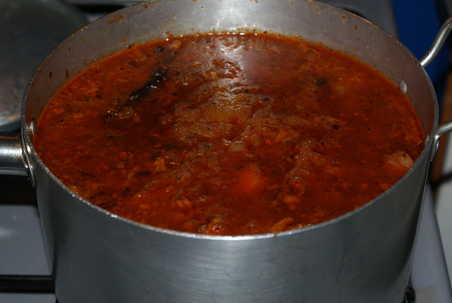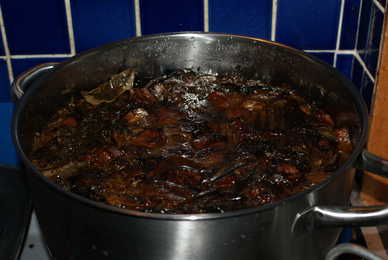Stocks. The Cooking Kind.
You know, sometimes I have to buy a chicken just to make stock.
It can be tough inventing stuff to do with all that poultry though.
It's also tough to keep stock for any length of time - which first means reducing it. That's a pity, because the stock never seems to be quite the same after boiling for a couple of hours so if you can manage to use it fresh, or make it fresh for what you need then so much the better.
Otherwise it will keep for a surprising amount of time (months even) in a sterilized mayonnaise jar in the fridge. That means a lot of reducing of course. You can reduce stock down to about a tenth or so before it starts to turn to glue.
I haven't really tried freezing stock much, but I'm thinking of trying out those little bubble packs you can get - they look like they might at least hold a decent amount.
I've never really figured out how to get a totally clear stock - and I'm wondering if it's even possible. (Or necessary.) Mine always end up at least a little bit cloudy.
You definitely want to avoid boiling like mad though. At least, until you've strained it.
Through four layers of muslin.
Maybe twice.
I pour the stock through a colander or a sieve first to strain out the bits and pieces, then run it through a muslin-lined sieve next. That way the muslin doesn't get so blocked up.
Oh and you'll need a bigger stockpot.
No. Bigger than that.
IKEA do a decent 10-litre pot for £35.
It's also tough to keep stock for any length of time - which first means reducing it. That's a pity, because the stock never seems to be quite the same after boiling for a couple of hours so if you can manage to use it fresh, or make it fresh for what you need then so much the better.
Otherwise it will keep for a surprising amount of time (months even) in a sterilized mayonnaise jar in the fridge. That means a lot of reducing of course. You can reduce stock down to about a tenth or so before it starts to turn to glue.
I haven't really tried freezing stock much, but I'm thinking of trying out those little bubble packs you can get - they look like they might at least hold a decent amount.
I've never really figured out how to get a totally clear stock - and I'm wondering if it's even possible. (Or necessary.) Mine always end up at least a little bit cloudy.
You definitely want to avoid boiling like mad though. At least, until you've strained it.
Through four layers of muslin.
Maybe twice.
I pour the stock through a colander or a sieve first to strain out the bits and pieces, then run it through a muslin-lined sieve next. That way the muslin doesn't get so blocked up.
Oh and you'll need a bigger stockpot.
No. Bigger than that.
IKEA do a decent 10-litre pot for £35.
Light Chicken Stock
ingredient soup fowl
Ingredients
1 chicken carcass
1 large white onion, peeled, roughly chopped
1 leek roughly chopped
2 celery sticks, roughly chopped
2 carrots, peeled, roughly chopped
1 head garlic, cut in half horizontally
peppercorns
bay leaves
thyme sprigs
parsley stalks
1 large white onion, peeled, roughly chopped
1 leek roughly chopped
2 celery sticks, roughly chopped
2 carrots, peeled, roughly chopped
1 head garlic, cut in half horizontally
peppercorns
bay leaves
thyme sprigs
parsley stalks
To make a light chicken stock, you need to avoid roasting, adding tomato purée or otherwise darkening the ingredients.
Gordon Ramsay believes that you shouldn't over-boil the stock - simmer for 30-40 minutes only.
I don't think I'd argue with that - a long-cooked stock seems to take on a rather mealy or cottony taste and loses the freshness of the herbs and vegetable ingredients, but we'd have to part company when it comes to boiling the stock, or adding salt though. Don't Do It.
Gentle simmer only, and no salt until seasoning the finished product.
Gordon Ramsay believes that you shouldn't over-boil the stock - simmer for 30-40 minutes only.
I don't think I'd argue with that - a long-cooked stock seems to take on a rather mealy or cottony taste and loses the freshness of the herbs and vegetable ingredients, but we'd have to part company when it comes to boiling the stock, or adding salt though. Don't Do It.
Gentle simmer only, and no salt until seasoning the finished product.
Method
Put the chicken carcass in a large pot, cover with cold water and bring to a boil.
Skim. Simmer gently for 10 minutes, skimming.
Add the remaining ingredients. Bring back to the boil. Skim.
Simmer gently without boiling for an hour (or less).
Allow to cool then strain through a double muslin-lined sieve.
Skim. Simmer gently for 10 minutes, skimming.
Add the remaining ingredients. Bring back to the boil. Skim.
Simmer gently without boiling for an hour (or less).
Allow to cool then strain through a double muslin-lined sieve.
Dark Chicken Stock
soup ingredient fowl
This makes the strongest, most delightful chicken stock.
It's almost rich enough to drink on its own and makes the most fantastic gravy.
The flour and tomato purée are a bit of a cheat though - if you're a purist.
It's even better if the chicken carcass happens to be from a poached chicken (such as this aromatic version or this one for coronation chicken, though perhaps without the ginger or cinnamon) and you use the poaching liquid instead of water to simmer up the roast stock bones and veggies.
The general ideas I followed here come from Anthony Bourdain's entertaining Les Halles cookbook
You need roughly equal volumes of chopped onion, leek, carrots and celery if using.
It's even better if the chicken carcass happens to be from a poached chicken (such as this aromatic version or this one for coronation chicken, though perhaps without the ginger or cinnamon) and you use the poaching liquid instead of water to simmer up the roast stock bones and veggies.
The general ideas I followed here come from Anthony Bourdain's entertaining Les Halles cookbook
You need roughly equal volumes of chopped onion, leek, carrots and celery if using.
Ingredients
1 roasted chicken carcass
4 Tablespoons tomato purée
2 Tablespoons sieved plain flour
1 large white onion, peeled, roughly chopped
1-2 leeks roughly chopped
2-3 celery sticks, roughly chopped pretty optional really
2-3 carrots, peeled, roughly chopped
1 head garlic, cloves separated and peeled
small handful peppercorns
few bay leaves
thyme sprigs
parsley stalks
Method
4 Tablespoons tomato purée
2 Tablespoons sieved plain flour
1 large white onion, peeled, roughly chopped
1-2 leeks roughly chopped
2-3 celery sticks, roughly chopped pretty optional really
2-3 carrots, peeled, roughly chopped
1 head garlic, cloves separated and peeled
small handful peppercorns
few bay leaves
thyme sprigs
parsley stalks
Preheat the oven to Gas Mark 6/200°C.
Strip the carcass and separate out the skin,
gristle and bones and place these in a baking tray liberally greased with olive oil.
Smear the bones generously with tomato purée, sieve over a couple of tablespoons or so of flour,
throw in a handful of peppercorns, stir through and put in the top of the oven to roast.
Liberally oil a second baking tray with olive oil and throw in the garlic cloves, and chopped vegetables except the celery. I reckon the celery wouldn't roast too well, so I saved it for the stock pot Scatter with thyme and any other dryish herbs you fancy, and slide into the oven a shelf below the bones
Roast the bones and vegetables stirring frequently for 1-2 hours or as long as it takes to finish them to perfection. You want the vegetables to have dried off and to be beginning to caramelise nicely.
The fat should have rendered out of the chicken skin and the bones dried off and darkened all over. Don't let this nice browning turn into bitter burning though.
When the vegetables and bones are ready, transfer them to a large stockpot, rinse off the baking trays into the pot too (unless you're planning on using the tray to fry up the roux for a gravy). Add any unused meat from the carcass, celery if using, bay leaves, parsley and any other herbs you fancy (rosemary,sage, tarragon etc) and cover with water or chicken poaching liquid. You could add some white wine here too — up to a pint
Bring the pot slowly to the gentlest of simmers, skimming regularly as foam appears. Even several hours simmering shouldn't be a problem!
Skim off any fat (you can drag sheets of kitchen paper across the surface of the liquid to do this), strain off the stock, and then strain it through several layers of muslin. You can do this further times if you want more refined stock. Reduce off the stock to use as necessary.
Liberally oil a second baking tray with olive oil and throw in the garlic cloves, and chopped vegetables except the celery. I reckon the celery wouldn't roast too well, so I saved it for the stock pot Scatter with thyme and any other dryish herbs you fancy, and slide into the oven a shelf below the bones
Roast the bones and vegetables stirring frequently for 1-2 hours or as long as it takes to finish them to perfection. You want the vegetables to have dried off and to be beginning to caramelise nicely.
The fat should have rendered out of the chicken skin and the bones dried off and darkened all over. Don't let this nice browning turn into bitter burning though.
When the vegetables and bones are ready, transfer them to a large stockpot, rinse off the baking trays into the pot too (unless you're planning on using the tray to fry up the roux for a gravy). Add any unused meat from the carcass, celery if using, bay leaves, parsley and any other herbs you fancy (rosemary,sage, tarragon etc) and cover with water or chicken poaching liquid. You could add some white wine here too — up to a pint
Bring the pot slowly to the gentlest of simmers, skimming regularly as foam appears. Even several hours simmering shouldn't be a problem!
Skim off any fat (you can drag sheets of kitchen paper across the surface of the liquid to do this), strain off the stock, and then strain it through several layers of muslin. You can do this further times if you want more refined stock. Reduce off the stock to use as necessary.
Beef Stock
ingredient soup meat
Makes a couple of pints of reduced stockIngredients
beef shin bones
2 carrots, peeled, roughly chopped
1 large onions, roughly chopped
1 leek, roughly chopped
2 celery sticks, roughly chopped
1 head garlic, broken into cloves
dozen button or half-dozen field or flat-cap mushrooms
thyme
bay leaves
peppercorns
Method
2 carrots, peeled, roughly chopped
1 large onions, roughly chopped
1 leek, roughly chopped
2 celery sticks, roughly chopped
1 head garlic, broken into cloves
dozen button or half-dozen field or flat-cap mushrooms
thyme
bay leaves
peppercorns
Put the bones in a roasting tin and roast at the top of a very hot (Gas 9/240°C/475°F) oven,
turning occasionally, until they are thoroughly caramelized (though not burnt) 45-60 minutes.
Fill another tin with the chopped vegetables (except the celery and field mushrooms), drizzle generously with olive oil and roast these too lower down the oven turning occasionally until they too are caramelized, but not burnt.
When everything is thoroughly browned, put the vegetables, bones, herbs and spices into a large pot and cover with water or if you happen to have boiled up some sheep innards, use the water from these.
Bring slowly to the gentlest of simmers, skimming any scum away as it floats to the top, then simmer for a couple of hours.
Strain the stock through muslin a couple of times until it's clear, then reduce as necessary.
Fill another tin with the chopped vegetables (except the celery and field mushrooms), drizzle generously with olive oil and roast these too lower down the oven turning occasionally until they too are caramelized, but not burnt.
When everything is thoroughly browned, put the vegetables, bones, herbs and spices into a large pot and cover with water or if you happen to have boiled up some sheep innards, use the water from these.
Bring slowly to the gentlest of simmers, skimming any scum away as it floats to the top, then simmer for a couple of hours.
Strain the stock through muslin a couple of times until it's clear, then reduce as necessary.
Mussel Stock
ingredient soup fish
A lovely rich fish stock, which makes a terrific base for a lemon risotto.
Makes 2-3 cupsIngredients
1 teaspoon fennel seeds
1 ½ cups white wine
2 oz butter
2 pieces celery, thinly sliced
4 cloves garlic, thinly sliced
2 lbs mussels, cleaned
1 small onion or 4 shallots, thinly chopped
tarragon or other herbs? Basil might be quite nice.
Method
1 ½ cups white wine
2 oz butter
2 pieces celery, thinly sliced
4 cloves garlic, thinly sliced
2 lbs mussels, cleaned
1 small onion or 4 shallots, thinly chopped
tarragon or other herbs? Basil might be quite nice.
Bruise the fennel seeds in a pestle and mortar, then dry roast them a little in your pan.
Then add the butter and sauté the shallots, celery and garlic until translucent.
In the meantime, reduce the white wine, or add the white wine to the shallots now and reduce by half.
Add in any herbs you might like. Add the mussels and cook for 3-4 minutes, shaking occasionally.
Remove from heat, cover and set aside to infuse for 15 minutes.
At this point you can shuck out the mussel bodies, throwing the remains back into the stock and setting the mussels aside to use in something else.
Strain the stock into a colander, then thoroughly through muslin.
Then add the butter and sauté the shallots, celery and garlic until translucent.
In the meantime, reduce the white wine, or add the white wine to the shallots now and reduce by half.
Add in any herbs you might like. Add the mussels and cook for 3-4 minutes, shaking occasionally.
Remove from heat, cover and set aside to infuse for 15 minutes.
At this point you can shuck out the mussel bodies, throwing the remains back into the stock and setting the mussels aside to use in something else.
Strain the stock into a colander, then thoroughly through muslin.
This made a beautiful risotto, plus you get a load of cooked mussels to do with what you like.
If you have any other bits of fish or seafood you can of course throw those in to the mix too, but since they might produce a lot of scum you should probably simmer those up separately, skim, then add in just the strained liquid.
The mussels are actually a bit bland as they come out of this stock (no salt or bacon after all) but you can spice them up with butter, chilli sauce and salt & pepper.
Then they're quite good served up with linguine.
Also I had the rather brilliant idea of making this the base for a risotto dish served with (tempura?) battered mussels served on top with a hint of butter and chilli sauce
If you have any other bits of fish or seafood you can of course throw those in to the mix too, but since they might produce a lot of scum you should probably simmer those up separately, skim, then add in just the strained liquid.
The mussels are actually a bit bland as they come out of this stock (no salt or bacon after all) but you can spice them up with butter, chilli sauce and salt & pepper.
Then they're quite good served up with linguine.
Also I had the rather brilliant idea of making this the base for a risotto dish served with (tempura?) battered mussels served on top with a hint of butter and chilli sauce
Unfortunately, when you prise open a raw mussel, the body is so smeared out all over the shells like fishy orange twine,
that you can abandon any hope of deep frying them.
Probably that's why you don't see tempura mussels on the menu!
Tempura oysters on lemon risotto works pretty well though.
Tempura oysters on lemon risotto works pretty well though.
John's Vegetable Stock
ingredient soup veg vegan
I've been keeping my eyes open for a good rich vegetable stock method -
most of the stocks I've made in the past have been a bit on the weedy side, frankly.
Though I haven't actually tried this one yet, John assures me that it's pukker.
Though I haven't actually tried this one yet, John assures me that it's pukker.
Makes 2-3 cups
Ingredients
- water, probably a couple of pints
- 3 tomatoes (diced)
- 1 stick celery (diced)
- 8-10 button mushrooms
- 1 tbsp black peppercorns
- 3 garlic cloves, crushed but whole
- 1 bulb of fennel (diced)
- ½ an onion (diced)
- ½ a leek (diced)
- 1 carrot (diced)
- 4 fresh parsley stalks (roughly chopped)
- 1 tbsp olive oil
Heat the olive oil in the stockpot over a medium heat and add the onion, fennel, leek and carrot.
Allow to sweat for 2-3 minutes.
Add enough water to cover the vegetables generously and turn the heat up to high.
Add the tomatoes, mushrooms, celery, peppercorns, parsley and garlic and stir. Cook at a rolling boil for 15 minutes.
Sieve the stock and discard the chunky bits. It will keep in the fridge for three days or can be frozen in batches.
Allow to sweat for 2-3 minutes.
Add enough water to cover the vegetables generously and turn the heat up to high.
Add the tomatoes, mushrooms, celery, peppercorns, parsley and garlic and stir. Cook at a rolling boil for 15 minutes.
Hmmm, I normally simmer my stocks considerably more gently than that!
Sieve the stock and discard the chunky bits. It will keep in the fridge for three days or can be frozen in batches.
½ teaspoon of Marmite or mushroom ketchup helps to enrich the stock too.
Pork Stock
ingredient soup meat
A nice and easy stock. You don't have to roast the bones first but it will give you a slightly richer, better-coloured result.
If you can lay your hands on the carcass left after a hog-roast then you're laughing!
If you can lay your hands on the carcass left after a hog-roast then you're laughing!
Ingredients
- pork bones
- couple of onions, quartered
- a few carrots, roughly chopped
- a few celery stalks, roughly chopped
- a few bay leaves
- bunch of thyme or other herbs
- whole black peppercorns
Toss the pork bones and black peppercorns to roast at Gas Mark 6 for half an hour or so until they're nicely coloured, but not burned.
Put them in a large pan with the quartered onions, roughly chopped carrots and celery, cover with cold water, and bring to the gentlest of simmers.
Skim off any foam which forms, throw in any herbs you like and continue barely simmering for 2-4 hours, skimming occasionally.
When the stock is dark and rich and the vegetables have collapsed and the sinew in the joints has started to disintegrate, pour through a colander to remove the larger pieces, and set to chill.
When cold you should be able to skim off the fat which will have set on the surface, then you can strain through fine muslin, reduce if you like and store until required.
Put them in a large pan with the quartered onions, roughly chopped carrots and celery, cover with cold water, and bring to the gentlest of simmers.
Skim off any foam which forms, throw in any herbs you like and continue barely simmering for 2-4 hours, skimming occasionally.
When the stock is dark and rich and the vegetables have collapsed and the sinew in the joints has started to disintegrate, pour through a colander to remove the larger pieces, and set to chill.
When cold you should be able to skim off the fat which will have set on the surface, then you can strain through fine muslin, reduce if you like and store until required.




I must say it didn't seem to do any harm to the finished product, which still seemed reasonably clear, but maybe that was partly because I was using it to make gravy rather than as a soup base, say.